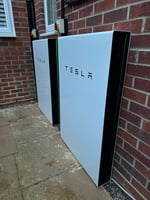Harnessing Solar Panels and Battery Storage A Solution to Mitigate Rising Energy Costs In an era...
Comparing the Tesla Powerwall vs Solar Panels: Which should you go for first?
Discover the benefits and differences between the Tesla Powerwall and Solar Panels to determine which is the best option to invest in first.
Understanding the Tesla Powerwall and Solar Panels
The Tesla Powerwall and solar panels are both innovative solutions for harnessing renewable energy. The Powerwall is a rechargeable lithium-ion battery that stores energy, detects outages and automatically becomes your home's energy source when the grid goes down. On the other hand, solar panels are devices that convert sunlight into electricity, providing a direct source of power. Understanding how these technologies work is essential in deciding which option to invest in first.

Solar panels are made up of photovoltaic (PV) cells that absorb sunlight and convert it into direct current (DC) electricity. This electricity is then converted into alternating current (AC) electricity through an inverter, which can be used to power household appliances and other electrical devices. The Powerwall, on the other hand, stores excess electricity from the grid or energy generated by solar panels, making it available for use during periods of low solar energy production or power outages. Both options have their advantages and would ideally be used together to create a sustainable and efficient energy system for your home.
Benefits of the Powerwall
The Tesla Powerwall offers several benefits for homeowners looking to invest in renewable energy solutions. First and foremost, it provides backup power during outages, ensuring that essential appliances and devices continue to operate. This can be particularly valuable in areas prone to frequent power outages or for individuals who rely on medical equipment that requires a continuous power supply.
Additionally, the Powerwall allows homeowners to take advantage of time-of-use electricity pricing. By storing excess electricity during low-demand periods, homeowners can use it during high-demand periods, reducing their reliance on the grid and potentially saving money on their energy bills. The Powerwall also enables homeowners to become more self-sufficient by reducing their dependence on the grid and increasing their overall energy independence.

Advantages of Solar Panels
Solar panels offer numerous advantages for homeowners interested in generating their own clean energy. One of the primary benefits is the potential for significant cost savings on electricity bills. By generating electricity from the sun, homeowners can reduce their reliance on the grid and potentially eliminate or greatly reduce their monthly electricity expenses.
Another advantage of solar panels is their positive impact on the environment. Solar energy is a renewable and clean source of power, producing no greenhouse gas emissions or air pollutants. By installing solar panels, homeowners can contribute to reducing their carbon footprint and combating climate change. Additionally, solar panels require minimal maintenance and have a long lifespan, making them a durable and cost-effective investment in the long run.

Key Differences Between the Powerwall and Solar Panels
While both the Tesla Powerwall and solar panels are beneficial in their own ways, there are key differences to consider when deciding which option to invest in first. The Powerwall is primarily a storage solution, allowing homeowners to store excess energy for later use. It can be particularly useful for individuals who experience frequent power outages or live in areas with unreliable grid infrastructure.
On the other hand, solar panels provide a direct source of electricity by converting sunlight into usable power. They are a long-term investment that can provide significant cost savings on electricity bills over time. Energy generated by solar panels is also eligible for various incentives including the Smart Export Guarantee (SEG) which you can read about on the government website. Octopus Energy offer an excellent outgoing tariff at 15p kWh, leading to further opportunities for money saving. However, it's important to note that solar panels alone do not provide backup power during outages.
Ultimately, the decision between the Powerwall and solar panels depends on your specific needs and goals. If you prioritise backup power and energy independence, the Powerwall may be the better initial investment. However, if you want to maximize your cost savings and reduce your environmental impact, solar panels should be your first choice. Many homeowners choose to invest in both technologies to create a comprehensive and sustainable energy system.

Deciding Which Option to Invest in First
Choosing whether to invest in the Tesla Powerwall or solar panels first can be a challenging decision. It's essential to evaluate your energy needs, budget, and long-term goals to make an informed choice. If you experience frequent power outages or have specific backup power requirements, the Powerwall may be the more immediate priority. However, if you are looking to reduce your reliance on the grid, save money on electricity bills, and contribute to a greener future, solar panels should be your primary focus.
Keep in mind that both the Powerwall and solar panels can be integrated into a comprehensive energy system. By combining the two technologies, you can benefit from backup power, energy independence, cost savings, and environmental sustainability. Consulting with us at BJC can help you assess your specific circumstances and guide you towards the best investment strategy.

In conclusion, understanding the benefits and differences between the Tesla Powerwall and solar panels is crucial in deciding which option to invest in first. Both technologies offer unique advantages and can be used together to create a sustainable and efficient energy system for your home. Whether you prioritize backup power, cost savings, or environmental impact, there is a solution that can meet your needs. Take the time to assess your requirements and consult with experts to make an informed decision that aligns with your goals and values.






